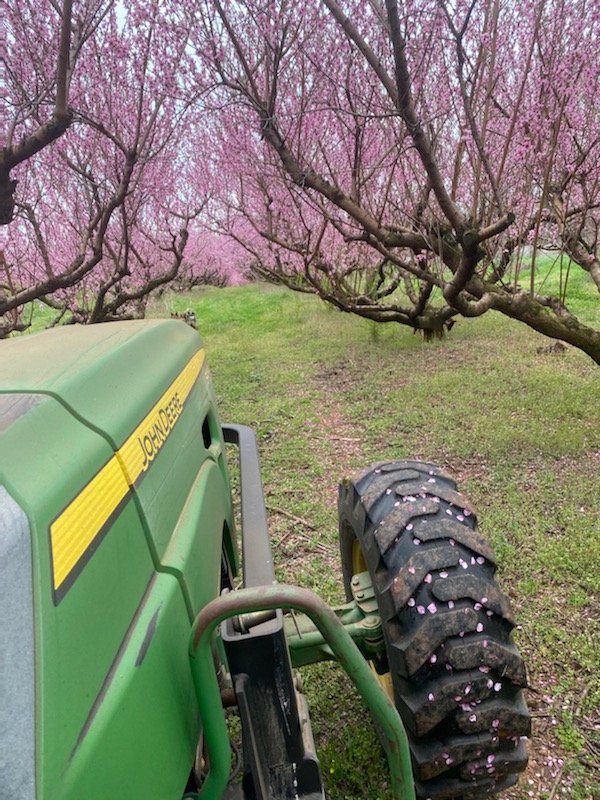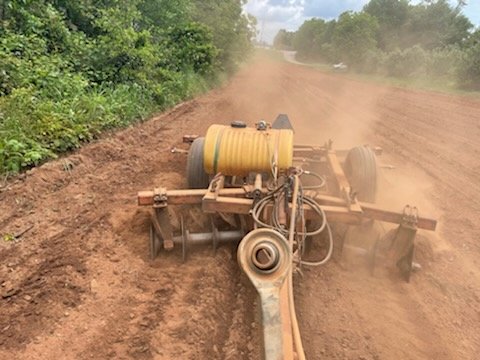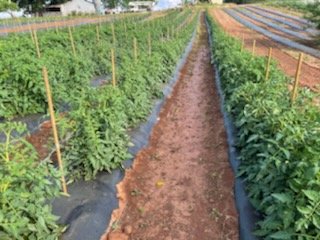All images are from @methodofmad.
I traveled across the widest part of Georgia, USA recently, and right through the heart of agriculture. Georgia is known as the Peach State, but produces a variety of crops like peanuts, pecans, produce (vegetables), cotton, and corn.
I meandered through the town of Fort Valley and weaved my way through Peach County, GA.
 peach trees blossoming in Georgia
peach trees blossoming in Georgia
There were rows and rows of peach trees and the next orchard was rows and rows of mature pecan trees. Then, I saw a unique format of peach trees with alternate rows of young pecan trees. Pecan trees need 7 to 10 years to begin producing nuts, so the farmer had alternated his rows so there would be peach production while the pecan trees were maturing. As the years pass, the pecan trees will shade out the peach trees, but by that time the peach trees will be near the end of their production cycle.
Increasing food production is very important. In the next 30 years, the world population will reach 10 billion people. Between now and 2050, food production needs to increase by 70 percent.* Some countries are already moving to indoor production.
I was surprised to see in Peach County a large glass greenhouse complex. Pure Flavor has a 75 acre facility that grows vegetables indoors. All around the facility are old school peach, pecan and crop row farmers. Indoor production has some advantages over outdoor production.
According to the University of Georgia Extension, farmers in Georgia will need to spend an additional $328 to $494 per acre on chemicals, pesticides and fertilizers this year, than last year for many outdoor row crops. That 29 percent increase in production cost will be difficult since margins are tight for farmers.

harrowing, tilling soil and adding herbicide
As the demand for food increases worldwide, farmers are also encountering pressure from environmentalist to reduce pesticides, conserve waters, and farm sustainably.
As farming has changed, so has the ability to feed people. In 1940, a single farmer produced enough food for 19 people.* Today, a single farmer produces enough food for 155 people. But that growth in production is a result of mechanization (industrial equipment versus human labor), chemical consumption (pesticides, fertilizers), and gene modification of seeds and plants. The cost to farm is called an input, and the food produced is called an output. While input of human labor has declined significantly, inputs of chemical, fertilizer and modified seed may have negative environmental impact.
Indoor facilities offer potential to reduce the input cost of chemicals, water consumption and loss of crop to weather conditions. Indoor greenhouse facilities use hydroponics and aeroponics. In addition, the amount of land needed is less. However, there are some negatives. Greenhouses consume energy for production, especially when facilities are used year round. Plants need artificial light and heat in winter. The initial cost of a facility is more than many farmers can afford. Which means production is concentrated among fewer corporate-owned farmers. In some rural areas and countries, utilities are not reliable enough for greenhouse production.

tomatoes as row crops
I clipped my Spring Vegetable Planting chart and put it on my refrigerator this week. Soon, I will prep my raised beds and then take some favorite seeds from the freezer. I will grow a variety of vegetables, all organically. But I know not everyone has the time, land or money for small scale farming. We are a big world with big population growth. How we farm in the next 30 years will determine if there is enough for everyone.
*statistics for this article are from Georgia Department of Agriculture, Farmers & Consumers Market Bulletin Vol. 104, No 25
Love the peach trees. Greetings from the Philippines!
I hope you are doing well. I know the typhoon hit some areas hard.
I am good, thank you.
Interesting take.
As a fellow aspiring small farmer, I think that 19 people mark sounds a lot better than 155. Or maybe 10 people. Two families. That can be done on a neighborhood scale in someone's yard. Cut out the mass monocropping, eliminating the petroleum inputs for both equipment and soil amendments. Someone on an apartment balcony could grow herbs and spices for their community pretty easily. Someone else in another apartment could have a flock of quail for eggs and meat for a family or two. It's far superior to grow your own and buy food from your friends, ask me how I know.
We don't need fewer people feeding more people, we need more people feeding people. It boggles my mind how we let our food production get so far removed from our communities. It's not okay. It's no wonder we're all fat and dying of the sniffles; we don't know anything about the food we eat except that it's not good for us!
That said, I love the staggered peach/pecan model. That's pretty wise actually, planning for the future and incorporating the two tastiest tree crops ever. No doubt their aim is to grow pecans, but peaches make a relatively fast crop to bankroll a project, usually producing in three years where pecans may be a decade before their first harvest. I wonder how long it'll take before the juglone from the pecan trees becomes a problem for the peaches. Probably not fast enough to make a difference in that model.
Thanks for that article, I reblogged it and shared it with a few friends off chain.
You are right. I mentioned in the article about the cost of pesticides and fertilizer per acre for most crops. It's more than $400 an acre. That's a really high cost both in dollars and environmental damage. The idea that produce must be blemish free (United States consumers anyway) results in overuse of pesticides and destruction of consumable food. I am in agreement with you about food production as a community. I grow most of my own vegetables and I rely on a mixture of new seeds and seeds that have been passed down in my family for generations. It's unfortunate in some ways that food is so cheap in the United States. Small gardeners have a tough time competing and justifying the time to can/preserve food is sometimes difficult when store food is easy and cheap. Don't get me wrong, I am with you on the need for more local gardeners and farmers. I hope to learn from your blogs and I appreciate the comment.
Oh my goodness, I typed a way longer comment than I thought! 🤣
That's kinda my pet topic though.
Where are you growing?
Northeast Georgia, but I am expanding onto some Southeast Georgia land this summer. Everything I do is more experimental than for money. I'm not sure of the path yet, but it has to feel like I am doing what is right for others and the environment. Long comments are good for me. I want engagement and advice from Hive.
I think if farmers heeded science backed advice of regenerative agriculture, they could probably make a better profit than they think, all at reduced environmental cost. I think a lot of it is about reinvigoration the soil biome. The Mayans did alright.. I'm sure we can find a way.
Peaches and pecans.. sounds heavenly.
I am pretty excited about adding to my raise beds this year. There's a mushroom grower that sells his compost that should be a great soil enhancer. It's $100 for 1,000 pounds. That show grow a lot of tomatoes for me!
Awesome!
Very smart of them planting both tress.i agree farming is and has to change. We are seeing more and more go organic and that's awesome but produces less so it is gonna be hard. We need more urban farming and more people growing their own food again.
We are working some raised beds so stay tuned for more posts from us. We are big on organic, but I'm not sure we can feed the world that way. and I think hyrdoponics can work well in urban areas. The growing will have to go vertical and indoors in a lot of areas. It's crazy that to get back to nature, we may have to build artificial growth chambers.
I raised quail this year. I think that quail are ideal for indoor and urban growers. The egg production is strong throughout spring, summer and fall. The birds are quiet and easy to keep. I want to try a hydroponic set up this year for some of my vegetables. Thanks for the comments and support.
Congratulations @methodofmad! You have completed the following achievement on the Hive blockchain and have been rewarded with new badge(s):
Your next target is to reach 200 upvotes.
You can view your badges on your board and compare yourself to others in the Ranking
If you no longer want to receive notifications, reply to this comment with the word
STOPTo support your work, I also upvoted your post!
Check out the last post from @hivebuzz: